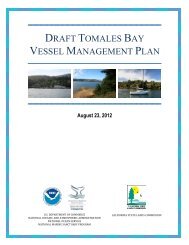Symposium program - Gulf of the Farallones National Marine ...
Symposium program - Gulf of the Farallones National Marine ...
Symposium program - Gulf of the Farallones National Marine ...
Create successful ePaper yourself
Turn your PDF publications into a flip-book with our unique Google optimized e-Paper software.
<strong>of</strong> <strong>the</strong> white shark C. carcharias incidentally caught is well known. However, little is known <strong>of</strong> <strong>the</strong> distribution,<br />
seasonality, movement patterns, or residence time <strong>of</strong> <strong>the</strong> white shark, C. carcharias in <strong>Gulf</strong> <strong>of</strong> California<br />
(GOC). A satellite PAT-Tag was attached to a ~280 cm total length (estimated, sex no available) white shark (C.<br />
carcharias) in <strong>the</strong> vicinity <strong>of</strong> San Pedro Nolasco Island (eastern central GOC) on November 7, 2004 and <strong>the</strong><br />
tag was successfully released on April 30, 2005, 166 km southwards. Maximum recorded depths by month were<br />
Nov 232 m, Dec 92 m, Jan 104 m, Feb 180 m and March 244 m. The monthly temperature ranges logged by <strong>the</strong><br />
tag were Nov 13.2-26.4ºC, Dec 18.2-22.7 ºC, Jan 16.2-21.3 ºC, Feb 13.9-20.2ºC and 13.2-22.3ºC during March.<br />
Tracking results indicate movements <strong>of</strong> <strong>the</strong> white shark into <strong>the</strong> Upper GOC.<br />
Hea<strong>the</strong>r M. McCann 1 , Nigel E. Hussey 2 , Aaron T. Fisk 1 , Sabine P. Wintner 3,4 , Geremy Cliff 3,4 , Sheldon F.J. Dudley 3,4<br />
and Brian J. Fryer 1 .<br />
1<br />
Great Lakes Institute for Environmental Research, University <strong>of</strong> Windsor, Windsor, Ontario, N9B 3P4. Canada<br />
2<br />
School <strong>of</strong> Ocean Sciences, College <strong>of</strong> Natural Sciences, Bangor University, Menai Bridge, Anglesey. LL59 5AB. UK.<br />
3<br />
KwaZulu-Natal Sharks Board, Private Bag 2, Umhlanga Rocks 4320, South Africa.<br />
4<br />
Biomedical Resource Unit, University <strong>of</strong> KwaZulu-Natal, PO Box X54001, Durban 4000, South Africa.<br />
Microchemistry <strong>of</strong> white shark (Carcharodon carcharias) vertebrae: a potential tool to age<br />
individuals and examine life-history strategies<br />
The microchemistry <strong>of</strong> calcified structures, such as fish otoliths, is becoming an important tool to elucidate<br />
life-history characteristics <strong>of</strong> marine animals over ontogeny. The corpus calcareum <strong>of</strong> shark vertebrae grows<br />
incrementally preserving a seasonal microchemistry signal (summer /winter) over <strong>the</strong> lifetime <strong>of</strong> <strong>the</strong> animal,<br />
similar to fish otoliths. The microchemistry <strong>of</strong> white shark (Carcharodon carcharias) vertebrae may provide an<br />
additional ecological tool to understanding individual life history patterns. Here we present baseline elemental<br />
concentration pr<strong>of</strong>iles for a 5.5 year old male white shark (280.6 cm PCL) sampled from beach protection nets<br />
in KwaZulu-Natal, South Africa. We assessed <strong>the</strong> potential <strong>of</strong> both a scanning electron microscope (SEM) with<br />
energy dispersive X-ray spectroscopy (EDS) and laser ablation inductively coupled mass spectrometry (LA-<br />
ICP-MS). The variation <strong>of</strong> calcium (Ca) across seasonal bands (SEM with EDS) showed that calcification was<br />
higher in <strong>the</strong> opaque bands than in <strong>the</strong> translucent bands. This suggests that current age estimates from growth<br />
ring counts could be validated using Ca concentrations as an indicator <strong>of</strong> season. A suite <strong>of</strong> elements (ranging<br />
in concentration from a few ppb to 1000s <strong>of</strong> ppm) were quantified using LA-ICP-MS in continuous transects<br />
along <strong>the</strong> corpus calcareum. Barium levels varied across growth bands suggesting ontogenetic movement<br />
between nutrient rich upwelling areas and non-nutrient rich areas. A number <strong>of</strong> non-essential elements (e.g.,<br />
uranium, lead) also varied across growth bands and may provide insights into ontogenetic migration and depth<br />
pr<strong>of</strong>iles <strong>of</strong> individual sharks. A number <strong>of</strong> essential elements (zinc, copper...) <strong>of</strong> <strong>the</strong> embryonic component <strong>of</strong><br />
<strong>the</strong> vertebrae were enriched compared to after birth and increased with age to levels approaching those in <strong>the</strong><br />
embryonic sections. These preliminary results show that a range <strong>of</strong> elements have suitable detection limits to<br />
aid in determining life-history patterns. Data for male and female white sharks <strong>of</strong> various sizes and ages will be<br />
presented.<br />
Mull, Christopher 1 , Lowe, Christopher 2 and O’ Sullivan, John 3 .<br />
1<br />
Institute for Integrated Materials Environments and Society (IIRMES); 2 Department <strong>of</strong> Biological Sciences, CSULB;<br />
3<br />
Monterey Bay Aquarium.<br />
Heavy Metals and Trace Elements in Juvenile White Sharks (Carcharodon carcharias)<br />
from <strong>the</strong> Sou<strong>the</strong>rn California Bight<br />
Evidence suggests that <strong>the</strong> white shark (Carcharodon carcharias) in <strong>the</strong> eastern north Pacific utilize <strong>the</strong> sou<strong>the</strong>rn<br />
California bight (SCB) as a nursery ground. Due to <strong>the</strong> proximity <strong>of</strong> highly urbanized locations a large amount<br />
<strong>of</strong> anthropogenic contaminants are introduced to <strong>the</strong> system, and juvenile white sharks are potentially exposed to<br />
relatively high levels <strong>of</strong> trace elements. To assess potential exposure levels, concentrations <strong>of</strong> 17 elements, including<br />
arsenic, selenium, cadmium and mercury were measured from <strong>the</strong> muscle and liver tissue <strong>of</strong> juvenile white<br />
sharks using inductively coupled plasma mass spectrometry (ICP-MS). Samples were collected from incidental<br />
mortalities <strong>of</strong> juvenile white sharks in <strong>the</strong> sou<strong>the</strong>rn California gill net fishery. There was no significant difference<br />
in concentration <strong>of</strong> arsenic, selenium or cadmium between muscle and liver. Average mercury concentrations were<br />
significantly higher in muscle (2.74 ± 0.61 μg/g dry weight) than liver (0.42 ± 0.07 μg/g dry weight) (p







